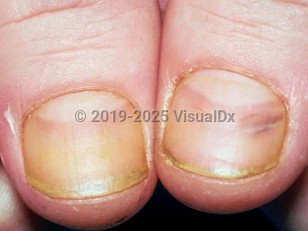Pesticide-induced nail changes - Nail and Distal Digit
Alerts and Notices
Important News & Links
Synopsis

The dipyridilium herbicides, paraquat, and diquat are widely used worldwide and may cause local reactions in the skin and nails of handlers (mixers, loaders, and applicators). Due to restrictions on its use, paraquat is not available for residential use, and, thus, reactions are limited to occupations with frequent exposure to commercial herbicides (farm workers, foresters). Toxic exposures to either concentrated or diluted paraquat occur in mixers or sprayers who fail to wear appropriate protective equipment.
Nail changes include transverse leukonychia, transverse ridging or furrowing, onycholysis, and nail shedding. Fingernails are most commonly involved, though toenail involvement has been seen in barefoot spray operators on coffee plantations in Kenya. Dinobuton handlers may present with yellow nails and hair. Paraquat exposure may also be associated with irritant contact dermatitis and paronychia of exposed fingers.
Nail changes include transverse leukonychia, transverse ridging or furrowing, onycholysis, and nail shedding. Fingernails are most commonly involved, though toenail involvement has been seen in barefoot spray operators on coffee plantations in Kenya. Dinobuton handlers may present with yellow nails and hair. Paraquat exposure may also be associated with irritant contact dermatitis and paronychia of exposed fingers.
Codes
ICD10CM:
L60.8 – Other nail disorders
SNOMEDCT:
17790008 – Disorder of nail
L60.8 – Other nail disorders
SNOMEDCT:
17790008 – Disorder of nail
Look For
Subscription Required
Diagnostic Pearls
Subscription Required
Differential Diagnosis & Pitfalls

To perform a comparison, select diagnoses from the classic differential
Subscription Required
Best Tests
Subscription Required
Management Pearls
Subscription Required
Therapy
Subscription Required
References
Subscription Required
Last Updated:05/24/2018
Pesticide-induced nail changes - Nail and Distal Digit

